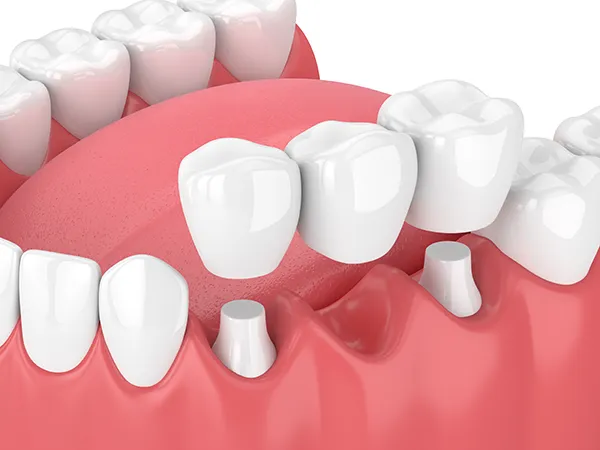Dental Bridge
Dentist McHenry, IL
 Dental bridges are used when you have a section of teeth missing, rather than a single tooth. There are several different types of dental bridges available, so we can select the perfect one to meet your needs. At McHenry Smile Center, we will guide you through this simple process and provide information for bridge maintenance after your procedure. Dental bridges are used when you have a section of teeth missing, rather than a single tooth. There are several different types of dental bridges available, so we can select the perfect one to meet your needs. At McHenry Smile Center, we will guide you through this simple process and provide information for bridge maintenance after your procedure.
Dental Bridge Options
We work with five different types of bridges; traditional, cantilever, Maryland, composite, and implant-supported. Traditional bridges are most preferred among our patients and can be used with either natural teeth or implants. One negative feature of traditional bridges is that they require more enamel to be removed. Cantilever bridges are not able to withstand as much bite force as traditional bridges, but they are great options when only one abutment tooth is available. Maryland bridges are more conservative and use metal wings to attach to abutment teeth. Composite bridges are used for very small gaps and are made of composite resin placed directly in these gaps. Implant-supported bridges are the most invasive, utilizing dental implants in the jawbone and gum. These are, however, the best choice for a natural look and they do not affect any other teeth. They are also easy to clean around.
Dental Bridge Process
The process differs slightly depending on what specific type of dental bridge you receive. Every procedure uses a local anesthetic if needed. Traditional bridges begin with our dentist filing enamel off of the two abutment teeth along the sides of the gap. This creates a support for the two dental crowns which will act as a base for the bridge. These crowns are placed over the filed teeth and attached to false teeth in the middle to fill in the full gap.
Cantilever bridges are similar to traditional, but they only use one abutment tooth. This is so, only one tooth will need to be filled and capped with a crown. These are not recommended for the back teeth, since they are a more fragile type.
Maryland bridges are resin bonded to abutment teeth with metal wings. These require very little work, if any, to be done on the abutment teeth. That said, they tend to lose their bond and discolor abutment teeth over time. So, they are not recommended as a permanent restoration.
Composite resin bridges, also called Ribbon bridges, are made by filling in the gap directly with the composite resin. This procedure can be done in a single day since a dental lab will not need to craft a bridge for you. However, this single procedure can take a while since our dentist must shape the resin to match your natural teeth. Resin is then hardened using a special light. This light works on dental cement as well. These bridges are fragile and, like Maryland bridges, only used as a temporary restoration option.
Implant-supported bridges can take several months to complete, due to the healing needed after the implant procedure. Our dentist does not need to do any work on the adjacent teeth. Bridges are cemented directly to the implants and fully supported that way. For more information on dental bridges, call McHenry Smile Center at
(815) 578-1000. |